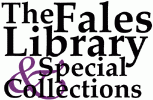Richard W. Rychtarik/Hart Crane Papers
Call Number
Date
Creator
Extent
Language of Materials
Abstract
Harold Hart Crane was born in 1899 and became a significant voice within modernist American poetry of the first half of the twentieth century. Crane moved to New York City and mixed with other prominent writers of the time and was influenced by both contemporary currents in poetry, and his early affinity for nineteenth-century French poets. In 1930, Crane received some acclaim from the publication of "The Bridge," his book-length poem that depicts New York City and his outlook on America in general.
Biographical Note
Harold Hart Crane (1899-1932) was born in Garrettsville, Ohio and became a significant voice within modernist American poetry of the first half of the twentieth century. Though without a college education and dissuaded from a career in poetry, Crane moved to New York City to write, where he met other prominent writers of the time, such as E. E. Cummings, Jean Toomer and Katherine Anne Porter. He was influenced by both the contemporary currents in poetry, such as T.S. Eliot, and his early affinity for nineteenth-century French poets, like Arthur Rimbaud. Most of his published material was written between 1924 and 1926. Crane's work was impacted by his difficulties with alcohol use and the homophobia he experienced. In 1930, he received acclaim and distinction from the publication of "The Bridge," his book-length poem that depicts New York City and his outlook on America in general. Crane had struggled to complete "The Bridge," and when he found himself particularly at a loss, he sought inspiration by traveling to an island near Cuba and Europe. Crane temporarily settled in Mexico from 1931 to 1932 on a Guggenheim Fellowship.
Arrangement
Folders are roughly arranged chronologically.
The collection corresponds to the arrangement of the scrapbook in which they had been housed. It is roughly chronological, though there are some photos and materials not in that order and other materials that were not a part of the original scrapbook. Printed materials and related correspondence are listed at the end of the collection.
Scope and Content Note
The Papers consist of letters, postcards, photographs, drawings, tearsheets, and clippings about Crane. Most of the items are typed letters signed by Crane to Charlotte and/or Richard Rychtarik. (Richard Rychtarik was an American set and costume designer of major productions at the Metropolitan Opera and other companies.) There are two letters from Waldo Frank to Crane, a handful of letters from Grace Hart Crane, and correspondence with Philip Horton. Among the photos are images of Crane in Brooklyn with the Bridge in the background, images of his rooms, of his visit to Woodstock, NY, and signed portraits, including one signed portrait by Walker Evans.
Subjects
Genres
People
Conditions Governing Access
Materials are open without restrictions.
Conditions Governing Use
This collection is protected by copyright and/or related rights. You are free to use materials in the collection in any way that is permitted by the copyright and related rights legislation that applies to your use. For other uses you need to obtain permission from the rights-holder(s).
Preferred Citation
Identification of item, date; Richard W. Rychtarik/Hart Crane Papers; MSS 103; box number; folder number or item identifier; Fales Library and Special Collections, New York University.
Provenance
The Richard W. Rychtarik Hart Crane Papers were the gift of the Richard W. Rychtarik Estate by Mrs. Gertrude Rychtarik. The papers were donated in September, 2000. The collection consists of letters, postcards and photographs, as well as some supplemental materials, that were kept by Mr. Rychtarik, a close personal friend of Crane.
About this Guide
Processing Information
The collection had been kept in a very acidic scrapbook which was disbound when the Fales Library received the materials. Many of the letters had been stapled to the acidic backing. These have been removed. When the backings contained information about the letters, they were retained. The scrapbook had its own numbering system, which is preserved on the folders and, often written on the letters themselves.
In 2021, narrative description was revised in the biographical note and abstract to edit harmful language regarding suicide, mental health, and substance use. Changes were made based on The Recommendations for Reporting on Suicide.
Researchers can access previous versions of the finding aid in our GitHub repository at https://github.com/NYULibraries/findingaids_eads/commits/master/fales/mss_103.xml.
